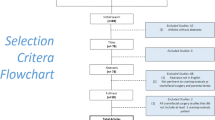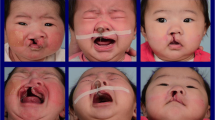Abstract
Purpose
There is a paucity of literature on how limitations of distraction osteogenesis (DO) are perceived by physicians and parents of pediatric patients. Specifically understanding which features of DO are most concerning to these two groups may better inform parent education, as well as direct improvements in distraction protocols and devices.
Method
Parents/guardians of patients (between January 2016 and October 2017) being treated with craniofacial distraction were recruited to complete a survey regarding level of stress (1 = not stressful, 9 = maximally stressful) associated with eight features of DO. Craniofacial surgeons completed a survey asking them to report (1) their personal level of stress and (2) their perceptions of parental stress regarding these same eight features of DO.
Results
Thirty-five parents and 15 craniofacial surgeons completed the survey. The risk of the device getting infected was perceived as most stressful by parents (5.5 ± 2.3) followed by the device sticking through the skin (4.9 ± 2.6) and the second operation for removal (4.7 ± 2.3). These same three features also elicited the highest level of stress among surgeons. Surgeon-perceived parental stress regarding turning of the distractor (5.8 ± 1.5) was significantly higher than parent self-reported stress (4.2 ± 2.8, p = 0.042).
Conclusions
Both parents and surgeons perceive risk of device-associated infection, the protrusion of the device through the skin, and the requirement of a second operation for removal as the most stressful drawbacks of distraction. Infection reduction protocols, less obtrusive devices, and devices that do not require removal are potential targets for stress reduction.


Similar content being viewed by others
References
Ayoub AF, Richardson W, Barbenel JC (2005) Mandibular elongation by automatic distraction osteogenesis: the first application in humans. Br J Oral Maxillofac Surg 43(4):324–328
Baas EM, van Gemert BPHM, Bierenbroodspot F, Milstein DMJ, de Lange J (2015) Patient discomfort and other side effects after bilateral sagittal split osteotomy or distraction osteogenesis of the mandible: a randomized clinical trial. Int J Oral Maxillofac Surg 44(9):1119–1124
Bredero-Boelhouwer H, Joosten KFM, van der Hoek VM, Mathijssen IMJ (2013) Family-centred care during midface advancement with a rigid external device: what do families need? J Plast Reconstr Aesthet Surg 66(8):1103–1108
Breugem C, Paes E, Kon M (2012) Bioresorbable distraction device for the treatment of airway problems for infants with Robin sequence. Clin Oral Investig 6(4):1325–1331
Burstein FD, Williams JK (2005) Mandibular distraction osteogenesis in Pierre Robin sequence: application of a new internal single-stage resorbable device. Plast Reconstr Surg 115(1):61–69
Cho B, Hwang S, Uhm K (2004) Distraction osteogenesis of the cranial vault for the treatment of craniofacial synostosis. J Craniofac Surg 15(1):135–144
Cohen SR, Holmes RE (2001) Internal Le Fort III distraction with biodegradable devices. J Craniofac Surg 12(3):264–272
Davidson EH, Brown D, Shetye PR, Greig AVH, Grayson BH, Warren SM, McCarthy JG (2010) The evolution of mandibular distraction: device selection. Plast Reconstr Surg 126(6):2061–2070
Denny AD (2004) Distraction osteogenesis in Pierre Robin neonates with airway obstruction. Clin Plast Surg 31(2):221–229
Denny AD, Talisman R, Hanson PR, Recinos RF (2001) Mandibular distraction osteogenesis in very young patients to correct airway obstruction. Plast Reconstr Surg 108(2):302–311
Fearon JA (2001) The Le Fort III osteotomy: to distract or not to distract? Plast Reconstr Surg 107(5):1091–1103
Fearon JA (2005) Halo distraction of the Le Fort III in syndromic craniosynostosis: a long-term assessment. Plast Reconstr Surg 115(6):1524–1536
Hopper RA, Aspinall C, Heike C, Andrews M, Sittler B, Saltzman B, Ose M (2009) What the patients and parents do not tell you—recollections from families following external LeFort III midface distraction. Plast Surg Nurs 29(2):78–85
Kevin M, Lloyd M, Evans M et al (2017) Experiences in performing posterior calvarial distraction. J Craniofac Surg 28(3):664–669
Maurice SM, Gachiani JM (2014) Posterior cranial vault distraction with resorbable distraction devices. J Craniofac Surg 25(4):1249–1251
McCarthy JG (1994) The role of distraction osteogenesis in the reconstruction of the mandible in unilateral craniofacial microsomia. Clin Plast Surg 21(4):625–631
Meling TR, Høgevold H-E, Due-Tønnessen BJ, Skjelbred P (2011) Comparison of perioperative morbidity after LeFort III and monobloc distraction osteogenesis. Br J Oral Maxillofac Surg 49(2):131–134
Molina F (2009) Mandibular distraction osteogenesis: a clinical experience of the last 17 years. J Craniofac Surg 20(8):1794–1800
Monasterio FO, Drucker M, Molina F, Ysunza A (2002) Distraction osteogenesis in Pierre Robin sequence and related respiratory problems in children. J Craniofac Surg 13(1):79–83
Nørholt S, Jensen J, Schou S, Pedersen T (2011) Complications after mandibular distraction osteogenesis: a retrospective study of 131 patients. Oral Surg Oral Med Oral Pathol Oral Radiol Endodontol 111(4):420–427
Ong J, Harshbarger RJ, Kelley P, George T (2014) Posterior cranial vault distraction osteogenesis: evolution of technique. Semin Plast Surg 28(4):163–178
Polley JW, Figueroa AA (1997) Distraction osteogenesis: its application in severe mandibular deformities in hemifacial microsomia. J Craniofac Surg 8(5):422–430
Rachmiel A, Aizenbud D, Pillar G, Srouji S (2005) Bilateral mandibular distraction for patients with compromised airway analyzed by three-dimensional CT. Int J Oral Max Surg 34(1):9–18
Rachmiel A, Emodi O, Rachmiel D, Aizenbud D (2014) Internal mandibular distraction to relieve airway obstruction in children with severe micrognathia. Int J Oral Max Surg 43(10):1176–1181
Rachmiel A, Nseir S, Emodi O, Aizenbud D (2014) External versus internal distraction devices in treatment of obstructive sleep apnea in craniofacial anomalies. Plast Reconstr Surg Glob Open 2(7):e188
Shetye PR, Grayson BH, Mackool RJ, MJ G (2006) Long-term stability and growth following unilateral mandibular distraction in growing children with craniofacial microsomia. Plast Reconstr Surg 118(4):985–995
Steinbacher DM, Skirpan J, Puchała J, Bartlett SP (2011) Expansion of the posterior cranial vault using distraction osteogenesis. Plast Reconstr Surg 127(2):792–801
Thomas GP, Wall SA, Jayamohan J et al (2014) Lessons learned in posterior cranial vault distraction. J Craniofac Surg 25(5):1721–1727
Tibesar RJ, Sidman JD (2008) Mandibular distraction osteogenesis in the pediatric patient. Curr Opin Otolaryngol Head Neck Surg 16(6):548–554
van Strijen PJ, Breuning KH, Becking AG, Perdijk FBT, Tuinzing DB (2003) Complications in bilateral mandibular distraction osteogenesis using internal devices. Oral Surg Oral Med Oral Pathol Oral Radiol Endodontol 96(4):392–397
Verlinden CRA, van de Vijfeijken SECM, Tuinzing DB, Becking AG, Swennen GRJ (2015) Complications of mandibular distraction osteogenesis for acquired deformities: a systematic review of the literature. Int J Oral Maxillofac Surg 44(8):956–964
White N, Evans M, Dover S, Noons P, Solanki G, Nishikawa H (2009) Posterior calvarial vault expansion using distraction osteogenesis. Childs Nerv Syst 25(2):231–236
Yonehara Y, Hirabayashi S, Sugawara Y, Sakurai A, Harii K (2003) Complications associated with gradual cranial vault distraction osteogenesis for the treatment of craniofacial synostosis. J Craniofac Surg 14(4):526–528
Author information
Authors and Affiliations
Corresponding author
Ethics declarations
Conflicts of interest
The authors declare that they have no conflict of interest.
IRB
This study has been approved by the Institutional Review Board for research involving human subjects at the Children’s Hospital of Philadelphia. All procedures performed in studies involving human participants were in accordance with the ethical standards of the institutional and/or national research committee and with the 1964 Helsinki declaration and its later amendments or comparable ethical standards. Informed consent was obtained from all individual participants included in the study. This article does not contain any studies with animals performed by any of the authors.
Data sharing
The data that support the findings of this study are available on reasonable request from the corresponding author [JT]. The data are not publicly available due to containing information that could compromise research participant privacy/consent.
Electronic supplementary material
Supplemental Table 1
Comparison of stress levels by diagnosis (PDF 69 kb)
Supplemental Table 2
Correlation between reported stress level and time of survey acquisition (PDF 59 kb)
Rights and permissions
About this article
Cite this article
Zhang, R.S., Lin, L.O., Hoppe, I.C. et al. Evaluation of parental and surgeon stressors and perceptions of distraction osteogenesis in pediatric craniofacial patients: a cross-sectional survey study. Childs Nerv Syst 34, 1735–1743 (2018). https://doi.org/10.1007/s00381-018-3827-5
Received:
Accepted:
Published:
Issue Date:
DOI: https://doi.org/10.1007/s00381-018-3827-5




